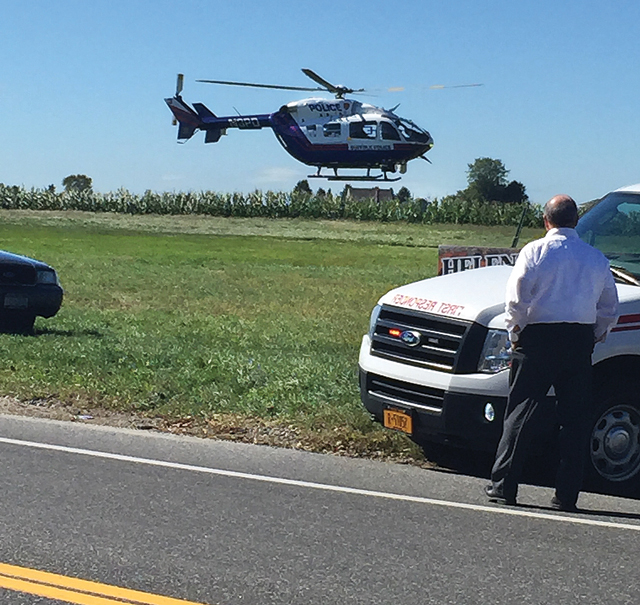Flown to safety: The process behind medevac flights

We’ve all seen them on their way to the scene of a dangerous accident.
They’re the blue and white Suffolk County Police Department helicopters, equipped with medevac services designed to move patients as quickly as possible to the county’s only Level 1 Trauma Center at Stony Brook University Hospital.
These emergency helicopters are lifesaving machines called when it seems an ambulance just won’t suffice.
But what’s the tipping point that constitutes air travel over a standard ambulance ride?
North Fork first responders say it all boils down to protocol.
“There’s time constraints on getting a trauma patient to a hospital — to a trauma center,” said Rod Richardson, assistant chief at Riverhead Volunteer Ambulance Corps. “With lights and sirens from Riverhead, it’s about a half-hour drive to Stony Brook. If the patient is out farther east, say Jamesport and Aquebogue, we need that helicopter to get the patient to the hospital within the time limits. It just makes life a lot easier.”
As explained in the 2014 edition of the Suffolk County Emergency Medical Services Advanced Life Support Protocol manual, calling a medevac is based on numerous circumstances, such as a patient’s condition and distance from a specialty hospital.
Injuries that qualify for airlift are those that require specialized care and medications, services offered by an air crew that can’t be offered by an ambulance crew, a “life or limb” threatening situation, critical burns or trauma.
Kevin Brooks, first assistant chief of the Riverhead Fire Department, said another consideration emergency medical technicians must make is the mechanism of injury, or the damage that occurs to the car involved in an accident.
“If the car is smashed up to a point where EMTs would assume that there were internal injuries … The ambulance makes that decision [to call a medevac],” Mr. Brooks said.
The county currently has four helicopters that are flown between 1,900 and 2,000 times each year. According to Suffolk County Police Department, there have been 1,484 missions since Jan. 1, 2015. Of these flights, 105 were to the North Fork, which means the towns of Riverhead and Southold have a combined average of approximately 2.6 flights each week. According to SCPD, the number of missions flown each year has remained relatively flat since 2010.
A major factor in deciding if a medevac needs to be called is figuring out the difference in ground and air transportation times.
Ground transport time factors in removing the patient from the scene and stabilizing them, loading them into the ambulance and driving them to the hospital. Elements that can delay travel time, such as weather, traffic, road conditions and time of day, also need to be considered.
For air travel, time calculation includes helicopter preparation, flight time to scene, drive time to landing zone and flight time to trauma center, as explained by the Suffolk County EMS protocol.
“If you need surgery at the MVA, [you can get] flown to Stony Brook and be in the OR within an hour,” Southold Fire Chief Peggy Killian said, calling it the “golden hour.” In medicine, the golden hour is the first hour after the traumatic injury occurs, which is considered the most critical for successful emergency treatment.

Suffolk County’s aviation unit was first launched in 1987, but medevac service to the North Fork was sped up with the introduction of a helicopter at Francis S. Gabreski airport in Westhampton in 2001. Previously, helicopters were only kept at Long Island MacArthur Airport in Ronkonkoma.
Although police helicopters are clearly beneficial, they’re not perfect. One downside is the cost of an emergency flight. While Suffolk County did not provide how much is billed to insurance companies locally, NBC News reported in 2009 that flights can cost up to $25,000 in some instances.
The cost to purchase helicopters can also be expensive for municipalities. Suffolk County spent $3.1 million in 2001 to purchase a helicopter, a cost that only covered the helicopter itself — not the staff, medicine, machines and jet fuel required to operate it.
A medevac also needs somewhere to land, a job that typically falls on the shoulders of the firemen or police officers at the scene.
“We usually have cookie-cutter areas around the town where we’ve used before and they’ve proven to be successful,” Chief Brooks said. “You want to land in areas free of wires, free of obstacles.”
Around Riverhead, these places include the County Center, the fire department’s training grounds on Northville Turnpike and County Route 105, their third substation in Calverton and sod farms, he said. In Southold Town, the local high schools, the Cutchogue Fire Department and Strawberry Fields are all common landing zone locations.
Even though there are locations that have been pre-determined as appropriate landing zones, they’re not the only places that can be used. Riverhead Town Police Chief David Hegermiller explained that landing zones are often chosen based on their proximity to the accident and can be anywhere deemed safe for the aircraft to land.
Additionally, if a helicopter is called, it doesn’t necessarily mean one will respond to an accident. Assistant Chief Richardson explained that helicopter pilots are first put on standby once an accident happens, allowing them to prepare for a flight. They’re then called once more, either confirming the need or canceling the medevac. This saves time, he said. When the definite “We need this” call is made, the pilot is all ready to go.
While the Suffolk County Police Department helicopters are best known for transporting critical patients from accidents, Chief Brooks and Southold Town Police Chief Martin Flatley said they are used for numerous other reasons, including responding to a home where someone is having a stroke and providing better vantage points for brush fires, car chases and missing persons cases.
“It’s invaluable,” Chief Flatley said. “You talk about that golden time frame that you have for a person that has a stroke or a heart attack or something [similar]; to get them to a trauma center like Stony Brook, it could never be achieved by use of ambulances. As far as from strictly a police perspective … The amount of times that we search for either boats out on the water or someone missing in fields, it gives us a great perspective and one that you can’t achieve any other way.”

